Introduction
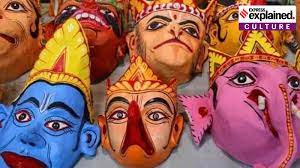
Mask-making is a cultural tradition that is practiced in several parts of India, each with its own distinctive characteristics and method of creation. Majuli, the world’s largest river island situated in Assam, is regarded as a significant center for this art form. As a major center of the Sankardeva-led neo-Vaishnavite movement, Majuli is home to several sattras who are skilled in mask-making.
Origin
Majuli’s mask-making tradition originated in the sattras, which are the cultural and intellectual establishments of the Neo-Vaishnavite movement’s adherents. Sankardeva introduced ‘mukha’, or masks, as props to be utilized in the theatrical performance called ‘bhaonas’ to depict the facial expressions of the mythological characters. The community prayer halls or naamghars are the setting for these traditional dramas.
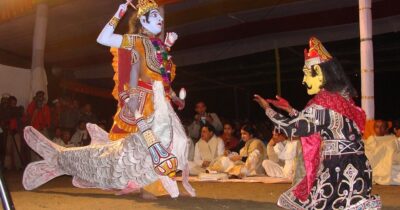
These theatrical dramas, also known as ‘Ankiya-bhaonas,’ are presented in a narrative style and depict episodes from the Ramayana, Mahabharata, and Bhagavat Puranas. The use of masks by the bhaoriya (actors) heightened the performance, making it more dramatic and visually appealing. Majuli’s mask making then flourished in different parts of Upper Assam at different sattras practicing Neo-Vaishnavism.
Sri Sri Samaguri Sattra in Majuli is one of the most important sattras that is commendable in the craft of mask-making. Established in 1663 by the grandson of Sankardeva, Sri Sri Chakrapani, this sattra has nurtured and preserved the craft of mask making for generations, passing the skill to numerous priests (bhakts) and artists.

Crafting process
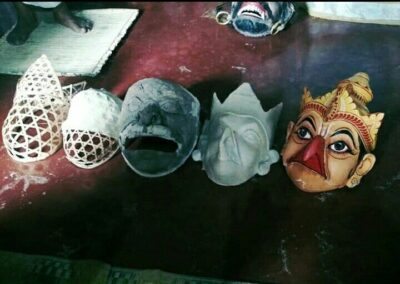
The first step in creating a mask is cutting a “jatibanh” which is a type of bamboo that is two to three years old, into a hexagonal shape according to the dimensions of the face. After that, a cotton towel dipped in potter’s clay is smeared over it. Once it has dried for some time, they structure the mask’s shape in accordance with the pattern by applying a second mixture of clay and cow dung to the mask to smooth out the surface. The artist creates the facial features of the mask at this point by using a scraper to sculpt elements like the crown, hair, mustache, and decorations into the semi-dry mask. After that, it is exposed to the sun to dry entirely.
The artist then applies natural dyes and colors to the solidified mask procured from materials like ash from oil lamps, vermilion, arsenic, indigo, bark, leaves, and plant sap. Since these masks are made from biodegradable materials such as bamboo, potter’s clay, cane, cow dung, jute, etc., they are not long-lasting and have to be preserved carefully.
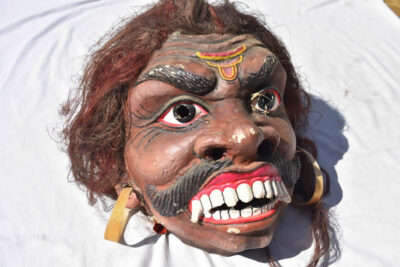
Types
Two kinds of mask can be found here—
Loukik (worldly): representing human beings and animals
Oloukik (otherworldly or supernatural): representing mystical beings from mythology and folklore.
Furthermore, masks are also crafted based on their structural utility, like
- Mukh mukha or mur mukha: those that only covers the face of the performers
- Bor mukha or su mukha: those that cover almost the entire body of the performers; they are three-dimensional
- Lutukai or Lutukoti mukha: smaller than bor mukhas, head and body masks are separate elements here that allow more flexibility.
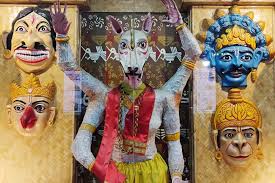
Significance of the craft
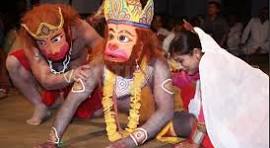
Neo-Vaishnavite traditions place great importance on these masks, which are more than just theatrical accessories. It is thought that a person wearing a mask while performing in a bhaona is the character in its entirety, appearing to have a mystical aura that takes them to another world. Masks are kept in the prayer halls with incense sticks and diya lamps surrounding them since it is thought that disrespecting the mukhas will bring misfortune.
Masks are also connected to a lot of rites and activities, and the region’s festivals and socio-cultural events wouldn’t be complete without bhaona performances. This theatrical art, which uses stories from religious scriptures, purposefully upholds the moral and spiritual values of the community. These plays have a strong spiritual component; they are dramatic, humorous, exciting, and devotional and help in fostering cultural and communal ties.
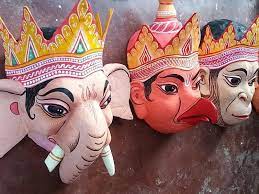
Motifs and themes
Since most of the stories played in the theatrical bhaonas are drawn from sacred texts like the Bhagavat Puranas, Ramayana and Mahabharata, masks serve as the visual storytellers. Masks are meticulously designed to reflect the character’s distinct emotions and features. The characters range from masks of gods, goddesses, demigods, mounts of the deities (vahans), animals, birds, demons and supernatural beings. Let’s take a look at them—
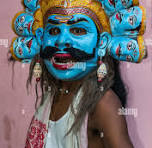
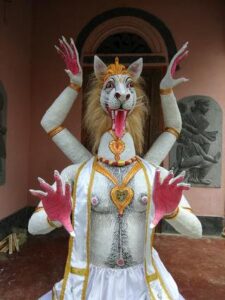
Masks representing the deities, commonly the ten avatars of Vishnu, such as the Matsya (fish avatar), Narasimha (half man, half lion), Varaha (boar), and Lord Ram. Other divine entities frequently portrayed are Shiva, Brahma, Ganesha, Hanuman, Garuda, Jatayu, etc. Actors have equipped these masks with fitting costumes that embrace the full magnitude of the character, and they are painted and embellished with exquisite detail.
Masks of demons are fierce and terrifying, crafted to invoke fear and awe among the audience. They feature exaggerated facial expressions, sharp teeth and villainous mustaches and are adorned with bold jewelry and ornaments. Iconic demon characters include the ten-headed Ravana, Kumbhakarna, Tarakasura, Putana, Bakasura, Dhenukasura, and Kaliya Naag. These masks help to communicate the stories’ moral and spiritual lessons while heightening the theatrical suspense that enthralls spectators.
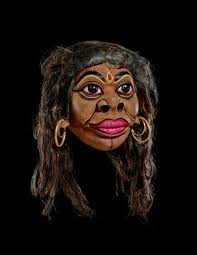
Current status
At present, due to the shortage of talented artists, Assam’s mask-making is only practiced in a small number of sattras in Majuli and in the districts of Jorhat and Sivsagar. Moreover, raw materials, natural dyes and colors are expensive leading to artists adopting synthetic dyes in painting the masks. Veterans of this craft live on an income that is only sufficient for their livelihood. Moreover, as the masks are made from perishable materials, the weather conditions of the region, particularly during the monsoons pose a big threat.
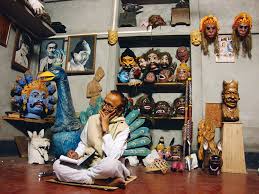
The masks of Majuli received a Geographical Indication (GI) tag in 2024, recognizing their authenticity officially. As representations of Assam’s cultural heritage, they are also on exhibit in the state and national museums. The government must take steps to conserve this 500-year-old art form by giving craftspeople financial support, promoting mask-making to young people through training programs and fine arts workshops, and displaying these vibrant masks at social and cultural gatherings.
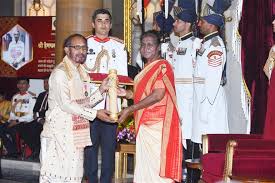
One prominent figure worth mentioning is Padma Shri awardee, artist Dr. Hemchandra Goswami, who hails from a long lineage of mask makers. As the current Satradhikar (head) of the Samaguri Sattra in Majuli, he has taken this craft to new dimensions. Notably, some of his masks are part of the British Museum’s permanent collection, making the craft known not only in India but to the world.
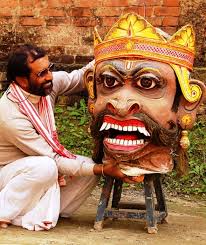
Conclusion
This vibrant craft rooted in the upper banks of the Brahmaputra, stands as an enduring art form of the state. In a generation where art forms are modernizing and evolving, mask making of Majuli remains a unique cultural tradition. To ensure that Assam’s rich legacy continues to inspire future generations, it is necessary to work for its survival while also fostering a renewed interest through cultural education and acknowledgement.
References
https://indianculture.gov.in/snippets/traditional-mask-making-culture-majuli
https://www.sahapedia.org/mask-making-tradition-assam-0
https://travellingslacker.com/chamaguri-satra-majuli-masks/
https://kaziranganationalparkassam.in/art-of-mask-making-majuli-island-assam/
https://garlandmag.com/article/the-sacred-masks-of-majuli/
https://gaatha.org/Craft-of-India/mukha-mask-making-majuli-assam/




